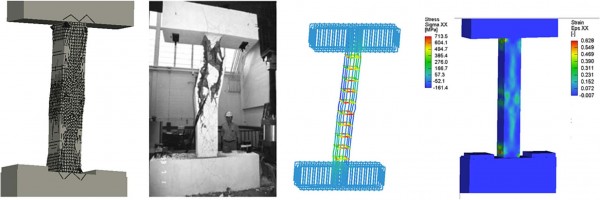기술자료 ATENA Evaluating the effects of loading protocol on the strength and deforma…
페이지 정보

본문
Evaluating the effects of loading protocol on the strength and deformation
capacity of Flexure-Shear critical concrete columns
Seyed Sasan Khedmatgozar Dolati *, Adolfo Matamoros , Wassim Ghannoum
Department of Civil and Environmental Engineering, University of Texas at San Antonio, One UTSA Circle, San Antonio, TX 78249, USA
A R T I C L E I N F O
Keywords:
Finite element
Reinforced concrete
Columns
Loading effects
A B S T R A C T
Columns are considered critical elements with respect to the stability of buildings during earthquakes. Concrete
columns with light confinement can sustain shear and axial load failures, which can lead to partial or complete
building collapse. Moreover, tests have indicated that lateral cycling of non-ductile columns can impart damage
that is cumulative. However, most experiments on concrete columns have used fully reversed cyclic loading
protocols, while earthquake ground motions tend to impart different types of lateral histories. Due to a lack of
experimental evidence considering the effects of lateral loading protocols on the strength and deformation capacity
of reinforced concrete columns, nonlinear continuum finite element models were calibrated to experimental
tests for seven columns subjected to varying lateral loading protocols. Selected columns sustained
flexural-shear modes of lateral strength degradation. Columns were selected to cover a range of shear stresses,
cross-section, axial loads, transverse reinforcement spacing and ratios, and longitudinal reinforcement ratios. All
tested columns sustained axial collapse after cumulative damage from lateral loading. Calibrated column models
were then subjected to a series of loading protocols, including monotonic pushover and fully reversed cyclic
loading protocols with varying number of cycles. The effects of the lateral loading protocols on damage progression,
strength, and deformation capacities are discussed for the columns in light of differences in peak lateral
strength, drift at peak lateral strength, drift at the initiation of lateral strength degradation, and drift at the
initiation of axial strength degradation.
1. Introduction
Many older reinforced concrete buildings have poor seismic detailing
and particularly columns with light confinement ([1,2,3]). When such
buildings are subjected to high-intensity earthquake loads, severe
damage can occur, as well as collapse ([4]). In fact, older non-ductile
concrete buildings are often the major source of deaths in earthquakes
([5,6,7,8]). Literature shows that the collapse of reinforced concrete
buildings in major earthquakes is typically associated with loss of
gravity-load carrying capacity of vertical members such as columns and
walls ([5,6,9]).
Experimental tests demonstrate that the behavior of concrete columns,
particularly at large damage states, is considerably affected by the
magnitude and history of lateral and axial loading ([10,11]). Nonductile
concrete columns can collapse due to high axial load, high
lateral displacement, or a combination of both. Experimental investigations
have shown that a column, which has been adequately
designed to resist gravity loads, experiences axial failure usually when
shear resistance degrades significantly [12]. In a test by Lynn [13], axial
failure occurred after a significant loss of lateral load resistance.
Experimental tests indicate that the flexural strength and displacement
capacity of columns under variable axial force were completely different
([14,15]). Tests by Melek et al. [16] indicate that the envelope of lateral
load versus lateral displacement relations depends on the axial load level
on columns. In tests by Ousalem [17], it is found that columns with
higher axial load experience more rapid strength degradation than those
with low axial load. In addition, the post-peak strength degradation
behavior was shown to be highly dependent on loading history. These
tests indicate that the lateral drift at which axial collapse occurs in tests
with lateral-drift cycles can be less than half that of columns pushed
monotonically in one direction ([10,11,18]). Experimental investigations
have shown that the flexural capacity of the section
considering loading history in some level of the axial load was significantly
less than the value calculated without considering loading history
([14,19]). In tests by Goodnight et al. [20], it is found that the symmetric
three-cycle set load history is more severe than the displacement history
첨부파일
-
1-s2.0-S0141029623000068-main.pdf (16.1M)
1회 다운로드 | DATE : 2023-02-13 17:10:31
- 이전글Durability enhancement of half-joints in RC bridges through external prestressed tendons: The Musmeci Bridge’s case study 23.02.13
- 다음글ACS SASSI SMiRT26 발표 자료 22.11.18
댓글목록
등록된 댓글이 없습니다.

